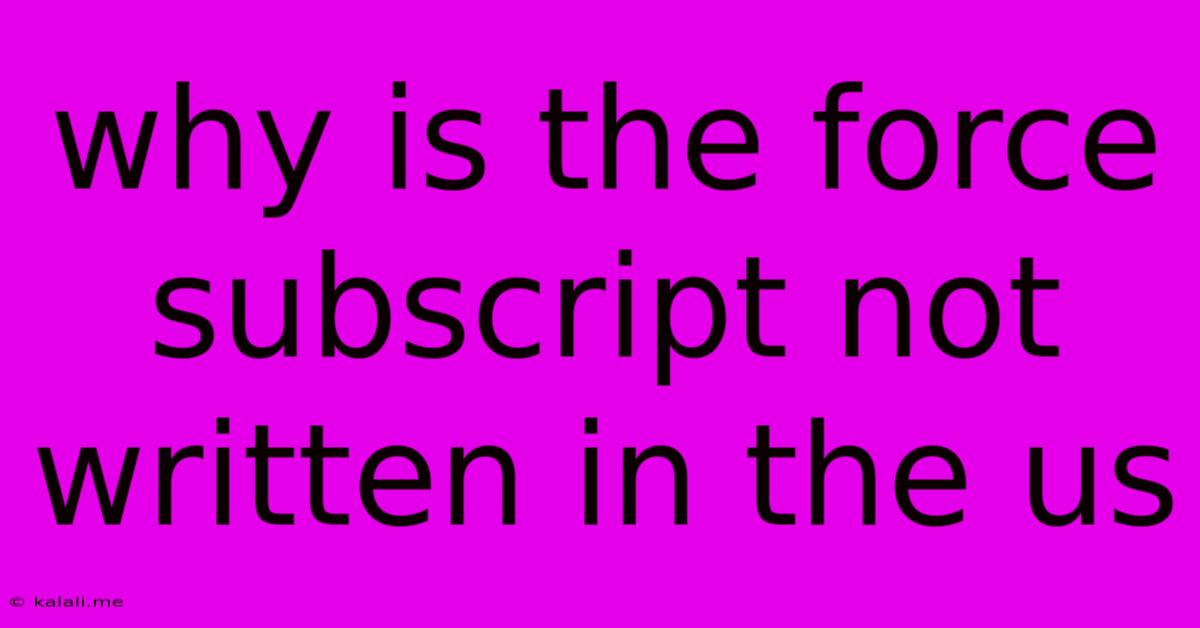Why Is The Force Subscript Not Written In The Us
Kalali
Jun 01, 2025 · 3 min read

Table of Contents
Why Isn't the Force Subscript Written in the US? Understanding the Absence of the °F Symbol
The question of why the degree symbol (°), specifically when referring to Fahrenheit (°F), isn't consistently written after the numerical value in the United States is a fascinating blend of historical convention, practical considerations, and evolving standards. It's not a simple answer, but rather a complex interplay of factors that have shaped current usage.
This article delves into the reasons behind the often-observed omission of the °F symbol, exploring its history, the various styles that exist, and the ongoing debate surrounding its proper usage. We'll also look at practical implications and how to best navigate this stylistic variation.
A Brief History of Temperature Scales and Notation
The Fahrenheit scale, developed by Daniel Gabriel Fahrenheit in the early 18th century, predates many standardized notation practices we take for granted today. Initially, consistent symbol usage for temperature scales was not universally adopted. Over time, the ° symbol gained traction, representing "degree," but its consistent placement (before or after the numerical value) and its association with specific scales (Celsius, Fahrenheit, Kelvin) evolved inconsistently across different publications and regions.
Style Guides and Publications: Inconsistent Practices
The lack of universal agreement on the placement of the °F symbol is a major contributing factor to its inconsistent usage. Different style guides, publications, and even individual writers often have their own preferences. Some publications, especially those focusing on technical writing or scientific accuracy, maintain strict adherence to placing the symbol after the numerical value (e.g., 72°F). Others, perhaps influenced by more casual writing styles or regional conventions, often omit it altogether (e.g., 72 F).
Practical Considerations and Readability
Beyond stylistic choices, practical considerations also play a role. In some contexts, especially in short-hand notation or casual settings, omitting the symbol might improve readability or save space. This is particularly true in fields where temperature readings are frequently reported and visual clutter needs to be minimized.
Regional Variations and Evolving Conventions
While the omission of °F is more prevalent in the US, it's not unique. Variations in writing styles and conventions exist globally. The evolving digital landscape, with its emphasis on brevity and efficiency, might also contribute to the decreased use of symbols, including the °F.
Best Practices for Clarity and Consistency
Despite the inconsistencies, ensuring clarity should be the top priority. When writing about temperature, choose a style guide and consistently adhere to it throughout your document. If uncertainty exists, using the symbol (°F) is generally considered safer, especially in formal contexts. If you are targeting a specific audience or adhering to a particular style guide (like the AP Stylebook or Chicago Manual of Style), follow its guidelines meticulously.
Conclusion: A Matter of Style and Context
The omission of the °F symbol in the US isn't due to a single, definitive rule. It's a combination of historical development, stylistic preferences, readability concerns, and regional variations. While no universally enforced standard dictates its absence, maintaining clarity and consistency in your writing is paramount. Choosing a style and sticking with it ensures accurate and understandable communication, whatever your choice. Ultimately, context is key, and the best practice involves making a conscious style choice and consistently applying it.
Latest Posts
Latest Posts
-
Panic Fork Exec Bin Sh Operation Not Permitted User Namespace
Jun 03, 2025
-
How To Clean The Gas Oven
Jun 03, 2025
-
After Cutting Into Floor Joist Where To Secure Mending Plate
Jun 03, 2025
-
Why Does Cross Product Give Area
Jun 03, 2025
-
What Does Oso Mean In Spanish
Jun 03, 2025
Related Post
Thank you for visiting our website which covers about Why Is The Force Subscript Not Written In The Us . We hope the information provided has been useful to you. Feel free to contact us if you have any questions or need further assistance. See you next time and don't miss to bookmark.